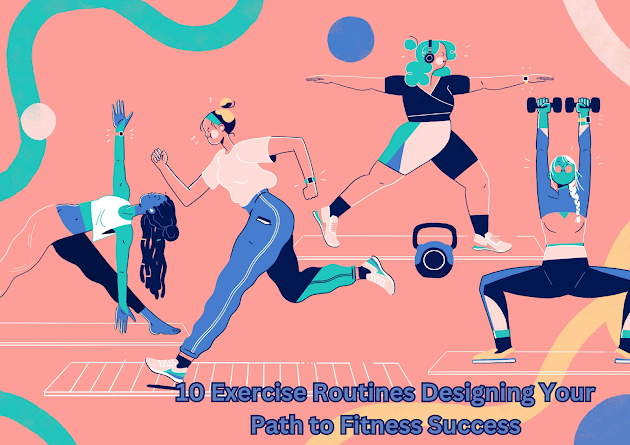10 Exercise Routines Designing Your Path to Fitness Success
Exercise routines play a fundamental role in achieving and maintaining a healthy and fit lifestyle. Whether you're a beginner or a seasoned fitness enthusiast, having a well-structured exercise routine is essential for maximising results and staying motivated. In this article, we will explore the key elements of effective exercise routines and provide guidance on how to design a routine that suits your goals and preferences.

10 Exercise Routines Designing Your Path to Fitness Success
1 Set Your Fitness Goals:
Start by defining your fitness goals. Do you want to improve cardiovascular endurance, build strength and muscle, lose weight, or enhance flexibility? Having clear objectives will help you tailor your exercise routine to align with your specific goals.
2 Choose the Right Exercises:
Select exercises that target different muscle groups and encompass a variety of fitness components. Include cardiovascular exercises (e.g., running, cycling, swimming), strength training exercises (e.g., weightlifting, bodyweight exercises), and flexibility exercises (e.g., yoga, stretching). This well-rounded approach ensures a comprehensive workout and helps prevent plateaus.
3 Determine Frequency and Duration:
Decide how often you will exercise and for how long. The American College of Sports Medicine recommends at least 150 minutes of moderate-intensity aerobic exercise or 75 minutes of vigorous-intensity aerobic exercise per week, along with two or more days of strength training. Break down your exercise routine into manageable sessions, such as 30 minutes of exercise five days a week.
4 Warm-Up and Cool-Down:
Always start your exercise routine with a proper warm-up and end with a cool-down. Warm-up activities should increase your heart rate and warm up your muscles, such as light cardio or dynamic stretches. Cool-down exercises can include static stretches to improve flexibility and promote recovery.
5 Gradually Increase Intensity:
Progression is key to continuous improvement. Gradually increase the intensity, duration, or resistance of your exercises over time. This progressive overload challenges your body and helps avoid plateaus. For example, increase the weight you lift, the distance you run, or the number of repetitions you perform.
 |
| 10 Exercise Routines Designing Your Path to Fitness Success |
6 Incorporate Variety:
Avoid monotony by incorporating variety into your exercise routine. Alternate between different types of exercises, try new activities or classes, and explore different environments (e.g., outdoors, gym, home workouts). Mixing up your routine not only keeps you engaged but also challenges your body in new ways.
7 Listen to Your Body:
Pay attention to your body's signals and adjust your routine accordingly. Rest and recovery days are just as important as exercise days. If you're feeling fatigued or experiencing pain, give yourself time to recuperate. This helps prevent overuse injuries and burnout.
8 Seek Professional Guidance:
If you're unsure about designing an exercise routine or need guidance, consider consulting a certified fitness professional. They can assess your fitness level, help set realistic goals, and create a personalised exercise program tailored to your needs and abilities.
9 Stay Hydrated and Fuel Your Body:
Hydration and nutrition are vital for optimal exercise performance and recovery. Drink water before, during, and after your workouts to stay hydrated. Fuel your body with balanced meals and snacks that include carbohydrates for energy, protein for muscle repair, and healthy fats for overall well-being.
10 Track Your Progress:
Keep a record of your workouts to track your progress. Note the exercises performed, sets, reps, and weights used. This helps you monitor improvements, stay motivated, and identify areas where you can push yourself further.
Conclusion:
Designing an effective exercise routine is an important step towards achieving your fitness goals. By considering your objectives, choosing a variety of exercises, gradually increasing intensity, incorporating rest and recovery, and seeking professional guidance when needed, you can create a routine that optimises your fitness journey








.png)

0 Comments